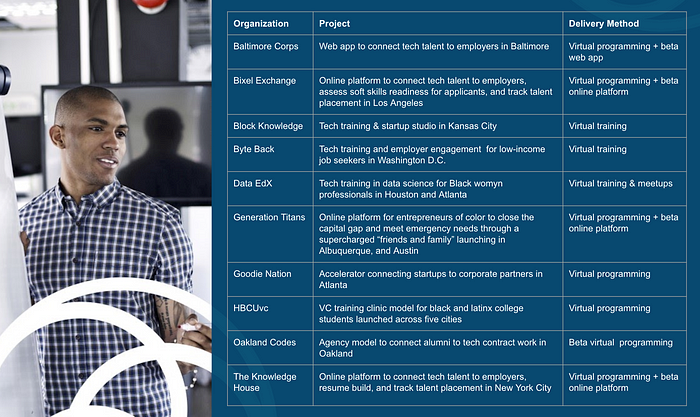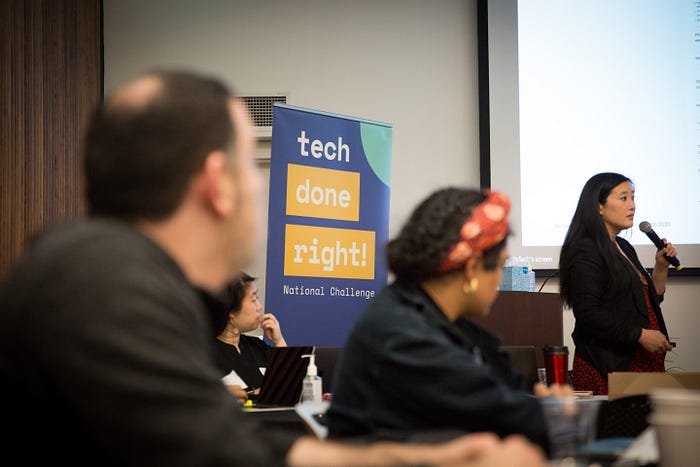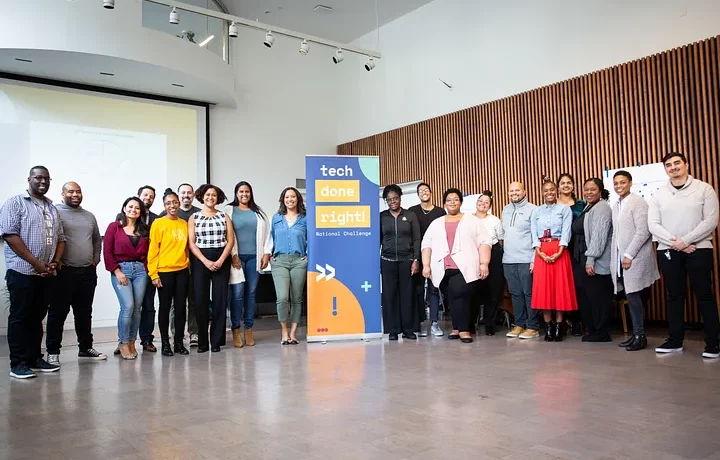The pandemic’s negative impact on BIPOC owned businesses and employees of color remains unprecedented. At the same time, the tech sector — a $1.4 trillion industry contributing 10.4 million jobs to the US economy — saw significant economic gains (estimated at $3.4T in value). Underrepresented women and people of color are disproportionately excluded from tech’s economic benefits. This disparity results from a complex set of structural and social barriers, or “leaks” that occur across the leaky technology pipeline and that will persist beyond COVID if not addressed.
So how do we build back from here, more equitably? We need to prioritize inclusive tech ecosystem building that holistically addresses leaks in local and regional tech pipelines. And we must incentivize solutions that put racial equity at the center of both design and implementation.
In 2019, the Kapor Center launched the Tech Done Right Challenge (TDRC), seeking to better understand how tech ecosystems are evolving across the country and identify organizations led by and/or primarily serving communities of color that are addressing systemic barriers to tech entrepreneurship and employment.
This national challenge pinpointed promising practices that stakeholders could utilize to scale across various ecosystems. From over 120 submissions, ten TDRC grant submissions were selected from which we conducted comparative analysis of diversity across eight tech ecosystems in the U.S. The eight ecosystems were evaluated highlighting the work of organizations before and during the pandemic with potential to be their cities’ anchor institutions to rebuild workforce training, employment, and tech entrepreneurship amongst BIPOC.
Key Insights from TDRC Report:
1. A comparative ecosystem metric is needed.
To provide a clear and meaningful summary of an ecosystem’s success in supporting a diverse tech workforce, we developed a Disparity Ratio. This disparity ratio focuses on the concept of underutilization, emphasizing an availability of talent, resources, and expertise from which the broader ecosystem is not deriving full benefit. Learn more about the Disparity Ratio across the eight ecosystems served in this TDRC Summary.

2. George Floyd’s death centered racial justice across the tech sector in an unprecedented manner.
When the COVID-19 pandemic first began its dramatic spike in early March 2020 — shutting down the economy shortly thereafter — the TDRC partner organizations found funding sources disappeared, budgets were re-prioritized and re-aligned, and goals shifted to deal with the devastating effects of the pandemic. We surveyed the organizations and identified three primary aspects: loss of funding, loss and shift of internal capacity, and loss of program delivery infrastructure. By May 2020, over a $1B were committed to racial justice by big tech after George Floyd’s death. This focus on racial justice positioned our grant partner organizations with newly found opportunities and funding at a critical time. Our grant partner organizations together serviced over 2,227 tech talent and 190 entrepreneurs of color.

“After the death of George Floyd, there was a whole new level of interest in what we were doing. Investors in Atlanta are putting more efforts toward getting capital to Black founders. Leading VCs and LPs, Atlanta corporations, they’re working on raising a $50M fund, while Goodie Nation is working with a well-known VC to deploy $5M in dilutive cash awards to top Black tech startups.”- Goodie Nation
“In April we got notified that the Mayor was going to cancel the summer youth employment program. This is a program that serves 75,000 youth. Can you imagine, that all these people would’ve lost the opportunity to get internships at tech companies, build their networks, make connections, get experience, build out their portfolio? It was devastating. So we just reached out, told them we have a tool that can help them host 1,000 interns, and we were able to move forward with a pilot program.” — The Knowledge House
“Due to Black Lives Matter movement, we’ve seen firms voicing a desire to diversify their staff NOW, and diversify their portfolios NOW. Because we’ve worked in this space for many years, we’re built strong networks of talent in the communities we support and were able to immediately respond to the needs of these firms and make connections for them. We have been successful in the expansion of our TDR project to include a $1M fund where our program participants can continue to learn about venture capital through direct experience, while entrepreneurs in our communities are receiving funding and support from trusted partners.” HBCU.vc
3. Tech Equity Policy is needed.

Policymakers seeking to increase access and opportunity for people of color should support coordination, network, and funding policies at local, regional levels. As we move forward we cannot afford to build without centering efforts on underrepresented women and people of color and investing in diverse leadership. We need to ensure private/public and institutional funders and policy makers collaboratively work to tackle the systemic barriers with even more urgency and investment.
Our TDRC grant partners provided insights about ways that their work can scale and their recommendations include (summary of report highlights HERE):
- Their local government needs to play a proactive role in aligning service providers and creating incentives along the tech pipeline, from K-12 through career and entrepreneurship opportunities.
- Ecosystem builders across the nation should be regularly convened, and given the opportunity to come together, collaborate, share resources, and co-create solutions.
- More funding transparency in order to reduce concentration in one section of the tech pipeline to the detriment of the others. A strong tech workforce fuels a thriving startup ecosystem, both of which depend on a solid STEM educational foundation. Yet without the latter, it is difficult to build a strong tech workforce, and without this workforce startups will migrate to other tech hubs where talent and capital will then accumulate, draining some ecosystems while enriching a privileged few.
- Need to diversify the pool of investors to diversify the pool of companies from which they source deals to distribute venture funding to traditionally-overlooked communities with multiplier effects.
- Invest in closing the digital divide and increase funding for digital adoption as a priority. Providing virtual training is very resource-intensive and not always possible for people in underserved communities. Systemic issues that underlie the digital divide have been exacerbated in an unprecedented manner.
Equity centered solutions centered on closing the wealth gap by leveraging the power of technology is a critical opportunity to rebuild our economy in a more inclusive way. To further this dialogue, the Federal Communications Commission’s Advisory Committee on Diversity and Digital Empowerment and FCC Media Bureau is hosting a virtual public forum Wednesday March 24th 10am EST focused on learning from diverse tech entrepreneurship support organizations and identifying potential national solutions.
Join the conversation here: www.fcc.gov/live


